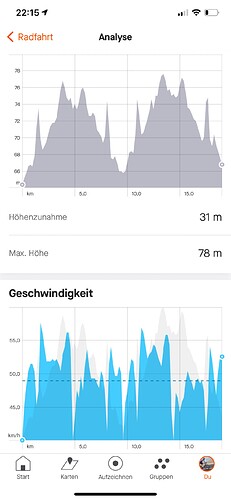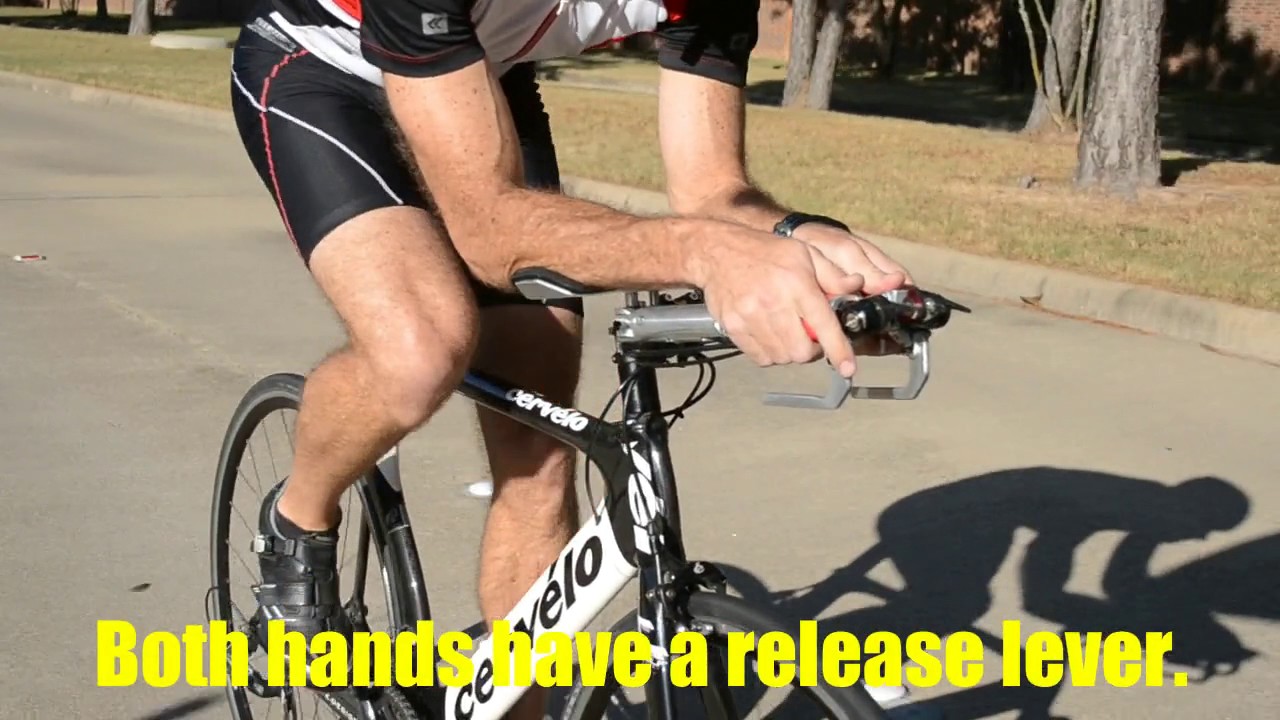I use an ISM PN 3.1, and I find I’m really sensitive to even small changes in saddle angle; so much so that I have bought a digital angle block to make sure I get it in exactly the right position (which for me is 3.5 degrees nose-down). However, when I get the angle right, I can find several comfy positions, although when I try hard, I do end up close to the nose.
I am currently planning my set up for my A+ race, a super flat TT, 20.4K in length.
This shows the profile (looks like double Ventoux in the picture, but it is 30 to 35 meters in total).
Below that, you can see the speed profile of a junior pro, who blew everyone out of the water on the course.
The course is double out and back, besides that no turns at all.
Sooo, it’s all about reducing drag and friction.
What I am wondering is, what gearing should I use here.
I really don’t expect to be sub 40kph (25mph) for anything more than 1 or 2 minutes in total.
The speed I aim at is around 48kph (30mph), if possible a little more.
I would like to spin faster, but I generally struggle to hold a cadence of more than 90rpm on the TT bike. Especially, since at a lower cadence, I tend to feel more stable on the bike (which has scientific basis - as I understand).
Long story long:
I am wondering about optimal gearing, really going after marginal gains.
That means avoiding cross changing, big sprockets for the chain to wrap around, as aero as possible etc.
The choice of 1x is rather straight forward, I think.
However, that kind of makes the choice of a ring a little tricky.
On an 11s, the chain line is optimal with the 15t, 16t, 17t.
For 48kph, that would be 62/15 … that’s crazy…
Campag 12s doesn’t help here at all. The most in line gears are 15, 16, 17, 19…
If I chose a 60t chainring, which is huge already, I am in between the 14t and 15t most of the Time.
That isn’t bad, but not really optimal.
SRAM 12s has 14, 15, 16, 17 as the most central gears.
Here again, a 61 or 62T chainring would be perfect to be in the low 40s in the 17t (I should hardly ever dip below this speed), 45 to 48kph in the middle to cogs, and just over 50kph in the 14t.
Is a SRAM 12s with a 62T chainring really the best option on the course? I have never seen anyone use it… then again, most people don’t build up bikes for one super specific course, that is also pan flat.
May I be better off with 2x, to shift the optimal chainline more towards the smaller cogs?
Would love to hear from you guys!
Get one from the UK, Aerocoach, drag2zero and watt shop and others all have 1x chainrings that can be make to fit your cranks.
Go big. 62, 63, 64 - you’ll scare the competition.
![]() - This really isn’t the goal, but might be among marginals gains, too
- This really isn’t the goal, but might be among marginals gains, too ![]()
Also, I know these chainrings exist.
And I have used PCD and AC chainrings.
I was rather wondering if I am off with my approach.
I just never saw anyone use a 62T on sram 12s and most people don’t even use it on the track (although the spin significantly faster than I can).
Are the three biggest cogs one piece? If so you could remove them and put in three 12 tooth cogs to shift everything left. Although shifting 3 might be too far, not sure.
Joe
I think your approach is right. Shimano do a 11-25 11-speed cassette that should work when I put your numbers into my spreadsheet. Its probably worth checking the actual chainline you have with a straight-edge. On my bike, I try to avoid the smallest 2 and largest 3 cogs, and best chainline is about 4th smallest. 62T chainring is big, but isn’t unusual. Go for it!
Is your seat height same/similar to other saddles?
Maybe I need higher front end with the ISM.
Sorry, @rawjunk - there’s no simple answer, I don’t think. Each time I have changed saddles, I try to watch this and re-check my saddle height.
A Simple Approach to Correct Saddle Height (for road cyclists) - YouTube
When I fitted the ISM, I started at the same seat height as the previous saddle, and I am probably within 5mm of that… but I have found I have been able to make changes to my position (like forward rotation of pelvis) that I couldn’t have done on my old saddle - and this has the effect of reducing “real” seat height a bit.
Edit: I just checked, and since fitting the ISM, my saddle is 15mm lower and the nose is 55mm further back.
Wondering if this might mean new shifters for TT bikes, too, to be released on 31st August 2021, with the other DA stuff.
![]()
Three thoughts on the ISM.
- I have a PS2.0 (actually an older Adamo Road) and it feels way better angled down. I have done really long TTs on it and it has been brill. I did try bringing the angle up and I too seemed to loose power. On my Boardman, the seat angle adjustment is notched, which is frustrating, but showing 2 notches is much better that one notch.
- I went to a bike fitter who was really careful to set up my saddle height and position so that he could tell when I lost tension in my legs as they became more straight. Its a fractional difference and makes an enormous difference. It might be worth you visiting a really good bike fitter and getting this right.
- I assume you have read the ISM articles of saddle height vs conventional saddles and where to measure the angles on them.
The cube details say Shimano Di2 2x12 gears and all groupset components subject to embargo until 31/8/21.
https://www.cube.eu/en/2022/bikes/road/triathlon-time-trial/
Pardon?
I think the issue was that if you put them in same position, you will sit way further back with the ISM. This article was a good read: Proper use of ISM and fi'zi:k - Slowtwitch.com
I put Fizik back on and instantly got my power back. Now I want to see what I can do with it since my shrug has improved. I’ll switch to ISM when indoor season starts or if I start feel any numbness/discomfort.
Its interesting (well to me anyway) that the non UCI version built for optimum speed is using rim brakes.
Cube seem to have done an amazing bodge-job with the pixels there. The highlight for me is the cassette, what secrets are they hiding in a cassette.
But yes, as you say new shifters would be nice - the non-hydro Di2 shifters are already pretty big, I think Hope suggesting they’ll make a hydro TT lever is really interesting - if somewhat irrelevant for me.
As an aside I am tempted to get rid of my Di2 shifters and just go for a plain lever + blip this winter when I get to work on my new front end.
The ISM site is really clear: they should be set lower and do NOT use the nose as the reference point, so
should not happen! Have you read this? Setup Guide | ISM Seat
I use a measure across where my hip bone site and have found that most saddles have a point that is 87mm wide. That is my reference point for saddle measurement.
Am rebuilding my Shiv this winter and doing that. The integrated shift/brake are huge. Functionality is good but big and ugly. Will set up the rebuild to have cowhorn (basebar) shift blips for complicated races and none for straight out and backs where cowhorn shifting is minimal.
Narrow bars - I’ve run the 3T Brezza Nano base for a long time. 30cm plus/minus. For folks thinking about narrow base bars, you need to be very solid with bike handling to run 30cm bars. Its a lot more difficult than it might appear. I’ve been riding and racing for about 40 years now and there are times when I’m not comfortable or happy with 30cm base bar. On the Shiv rebuild, am going back to the 40cm Brezza.
A long time ago, there was a guy who was chasing every aero watt. He actually ran no base bar. Rather, he used a Scott “loop” with thumb shifters at the end and levers on the extensions. No thanks, but it looked wild.
History buffs might remember the Scott Extreme Aero bars, These were just over 30cm
https://picclick.com/Scott-Extreme-Bar-Aero-Drop-36CM-NOS-Vintage-202597468507.html



